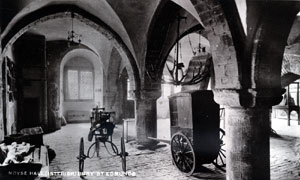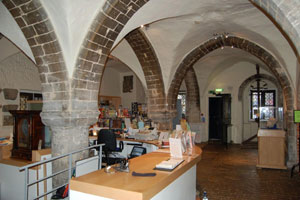
This is a pommel from an anglo-saxon dagger. It is intricateley carved in the old pagan manner. |

The Fornham Sword was found at one of the Fornhams, and is believed to date back to the Battle of Fornham in 1173. Its find site is a little unclear, but it was found before 1876, possibly in a muddy ditch near the water mill at Fornham St Martin. One side has the inscription "SES BENEDIC TAS", and the other, "+ I NOMINE DOMIN" or 'Be thou blessed / In the name of the Lord'. |

This carving of a monk reading from the bible is 14th or 15th century, and was found within the grounds of the Abbey of St Edmund. |

This is a misericord from the monastic period ending c 1539. It was a tip-up seat for standing monks to lean on during long services. They were often highly carved as is this example. |

Medieval objects. The large wooden object is a ceiling boss depicting a "Green Man", possibly 14th or 15th century. Two jugs are 14th century unglazed earthenware from Soham. The partly lead glazed mug is 15th century. 14 is a steelyard weight in bronze with the arms of the De Clare family. Edmund, Duke Cornwall, married Margaret de Clare in 1272, and as Master of the Mint, Edmund had a monopoly on weight production. Edmund died in 1300. This weight was found at Fordham. |

This bronze mortar is from the foundry of Stephen Tonni, and is dated 1577. After the reformation church bells were discouraged, and Tonni's bell foundry turned to the production of domestic objects. This mortar includes the initials TEE, probably relating to its owner, and may have been for alchemical use or for mixing gunpowder, rather than in the kitchen. |

This is a painting of the Cellerar's window at St Edmund's Abbey. It is dated circa 1560, and was therefore painted after the destruction of the abbey. |

This water tank, from the Abbey of St Edmund, has an inscription which reads,
"Your long hunt for a drink had better end here man and for all gifts thank the Lord." |

This carved stone head comes from the Abbey of St Edmund, and dates to about 1140. It was found as part of a wall in 1994, and so may come from the period in the 1430s when the West Front collapsed. Broken stones were simply incorporated into the rubble infill of the newly rebuilt West Front. |

Bell founders had a hard time after the Reformation. By 1576 it was accepted that churches needed bells, and this one was made by Stephen Tonni of Bury St Edmunds. It came from St Mary's church at Walsham le Willows, and is irrepairable because of a crack. |

Abbot Samson of Bury Abbey died in 1211, after being Abbot since 1182. This silver gilt band adorned his abbot's staff or crozier, and was found when his grave was opened in 1903. |



